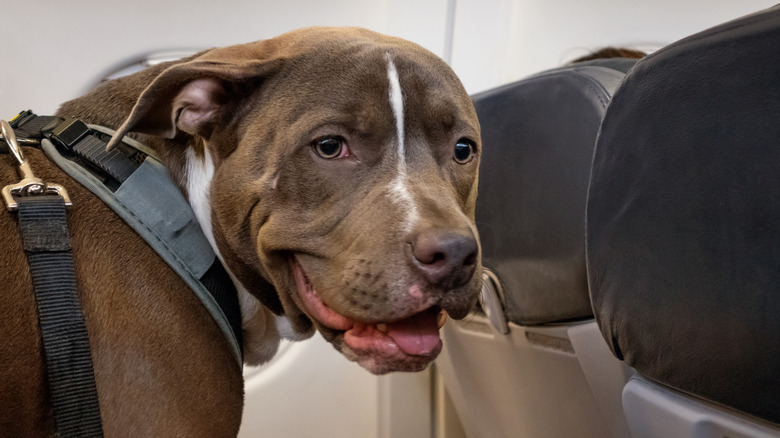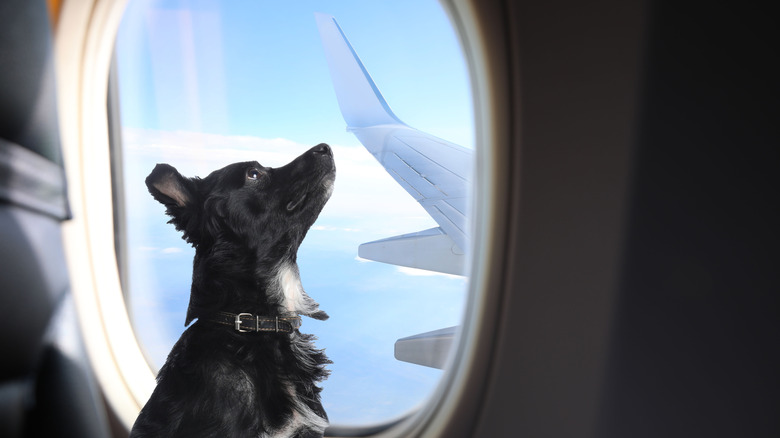The No. 1 Social Dog Rule Travelers Agree On For In-Flight Etiquette, And It's Not What You'd Think
"If you could enforce one social rule during flights, what would it be?" Take a moment to reflect on your answer (there are infinite options). In a very unofficial social media poll by Upworthy, a website dedicated to promoting positive, feel-good stories and viral happy endings, people were asked about their airplane proclivities, answering that very question. Honestly, it can oscillate between illuminating and fuming to read these kinds of conversations and reflect on airplane stories bad enough to make you hug a flight attendant, or being forced to reckon with your own inconsiderate tendencies (AITA?).
Upworthy's poll was an open-book, open-ended question that opened cans of worms regarding what people think are airplane passengers' worst in-flight behaviors. Answers ranged from "no manspreading," to letting passengers with connecting flights disembark first, to having flights without kids or babies, to "try to control flatulence," which sparked discourse about how to combat farts on planes. (Note to self: Carry emergency menthol rub or inhalers to sniff should I unluckily be seated near someone who's presumably eaten a plate of beans before boarding.) But the number one most-loved comment out of more than 3,800 was this: "Any dog on the plane has to visit every passenger that requests."
This suggested social rule for flights sparked delighted dialogue, with mostly positive reactions from "Yass!" to "perfect rule," to "this is the way!" Some passengers agreed, with the caveat that this rule only applies if they're pets or nonworking service animals — since, after all, the public should never touch a working service animal. While airlines and the Transportation Security Administration (TSA) already have rules for dogs on flights, the consensus was clear: Most people love dogs and want to interact with them, even while hurtling through the air in cramped metal tubes.
Dogs are therapeutic
Studies over the years have shown that people tend to prefer dogs over cats and are willing to spend more to keep them healthy and happy. A 2023 Pew Research Center survey also found that 97% of Americans consider their pets to be family, and more than half even say they love their pets as much as human family members. It's well-documented that dogs provide therapeutic benefits to humans and are said to have a near-uncanny ability to sense human emotions, offering comfort and feedback in incomparable ways. Animal-assisted therapy (AAT) dates back to ancient Greece and isn't exclusive to dogs, but in modern times, the domestic dog industry has become a flourishing business. According to a 2024 article in The Guardian, the pet industry overall is thriving. Between doggy day care, training, food, medical care, toys, recreation, and travel, the U.S. market for all pets was projected to reach $150 billion within the year — and $500 billion worldwide by 2030.
When up to 40% of Americans report a fear of flying, and flights are experiencing more fear-inducing turbulence thanks to climate change, maybe petting dogs on planes is part of the answer. When I was in college, a student organization partnered with a local rescue to bring puppies to campus during finals week — a stress-relief event now common at universities. "Yeah, they are more and more common. Often called 'puppy rooms' or something similar," one Reddit user commented on a thread about this topic. "It's a dog-hug-dog world out there." Another chimed in on the Upworthy poll, "I get to sit with your dog in the jump seat ... please bring a lint roller, I wear black," (Um, lint rollers for every seat along with our bag of peanuts, please?)
Having dogs on board could lessen stress
One of the most aggravating things that can happen on a flight is a crying baby or restless child, no matter how long the trip. Studies have shown that dogs can help lower cortisol levels — the stress hormone — in children. Imagine a dog meeting an anxious child mid-flight and soothing them into peace and quiet for the duration. Game changer! Interacting with dogs also stimulates the release of oxytocin, the "feel-good hormone," promoting calm, connection, and lower stress. In other words, dogs don't just make flights cuter; they make them quieter and kinder, too.
Of course, we should all be mindful of the common mistakes people make when traveling with pets, and yes — lots of fur floating around the cabin might not be ideal even for the allergy-free among us. Allergies and sensitivities are, of course, a valid concern; some travelers simply can't be around dogs, no matter how much they love them. To that end, the solution might lie in designated, pet-friendly flights. But if you're among the rare few who don't like the idea of meeting a dog in public, the dog might not even be the problem — maybe the owner is. Dogs are the goodest boys and sweetest girls — and the most therapeutically helpful — when they're well trained and well cared for.
In 2020, the U.S. Department of Transportation made it more difficult to classify emotional support animals (ESAs) as service animals. That shift created more hurdles for pet owners who want to fly with their animals. Some have turned to BarkAir, a niche airline that prioritizes pets over people. It's a charming concept, but, according to the Upworthy survey, passengers don't want dogs on private jets — they want them in their cabin.


